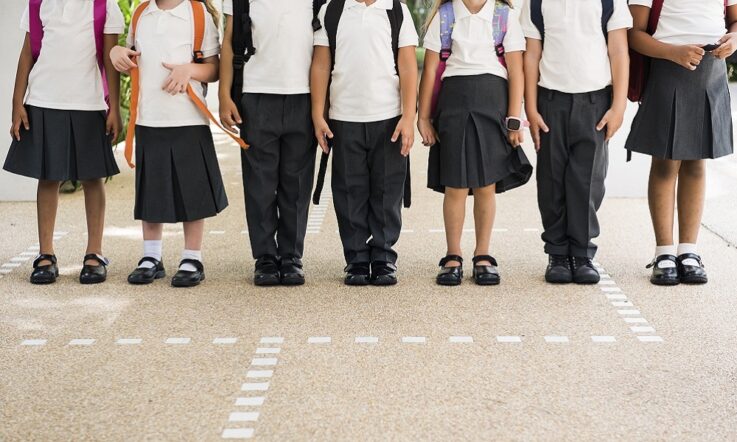Academic reading skills, such as summarising and note taking, are fundamental to academic success. It is often assumed that students already have these skills when they enter secondary school – however, they are not always explicitly taught.
At St Rita’s College in Clayfield, Brisbane, staff noticed wide variation in student academic reading skills, particularly during the transition into Year 7. They also noticed that if a low level of skill was left unaddressed it reduced student academic competence, self-efficacy, engagement and wellbeing.
The St Rita’s staff recognised the need for an evidence-based approach to support student academic reading skills.
A school-centred research partnership
St Rita’s partnered with the Science of Learning Research Centre (SLRC) and with Evidence for Learning (E4L) in an initiative supported by the Queensland Catholic Education Commission (QCEC) called the Research Partner Schools Program (RPSP). The RPSP is based on the SLRC’s school-centred partnership approach to research translation.
In the ‘Lost in Transition’ project, the RPSP team worked alongside the St Rita’s team to investigate how research can best help to address an authentic problem of practice. Research often doesn’t translate well into educational practice because the context of research is often removed from the complex realities of classrooms (Daniel, 2012). Such context differences between where research is conducted and where it is applied can make it difficult to develop classroom-ready applications and can undermine educators’ confidence in the relevance of research findings (Joram et al., 2020).
Research from literature and the school context
Therefore, the RPSP program merges research from the literature with research in the context of the school to establish a fuller understanding. To establish a strong evidence base for their subsequent reading skills intervention, the team at St Rita’s drew upon numerous key findings from the literature.
Firstly, academic success is linked to a student’s ability to understand a variety of texts and to be able to effectively take notes (Makany et al., 2009; Swanson & Wanzek, 2013). Secondly, students’ background knowledge and vocabulary level impact their comprehension and therefore pre-testing for content knowledge is important (Kamhi & Catts, 2017; Sibug, 2014).
Thirdly, visualisation and clear structures using matrices have been found to support engagement, knowledge transfer and metacognitive practices (Sibug, 2014). Moreover, research emphasises successful literacy strategies should be both explicitly taught and embedded within authentic learning experiences that align with the curriculum (Alton-Lee, 2003; Myhill, 2006; Squire, 1999).
Overall, the evidence suggests that a best practice intervention to improve reading skills requires the activation of prior knowledge, stepped instruction, and explicit teaching of strategies.
The St Rita’s team selected two evidence-based strategies to introduce in their academic reading skills intervention: the Cornell Note-Taking strategy and Sharon Crone’s Fly-Hunt academic reading strategy (Queensland Curriculum and Assessment Authority, 2015).
Preparation and implementation
During the intervention, Year 7 teachers underwent professional development in utilising both strategies. The St Rita’s research team also provided individual coaching and modelled each strategy in classes. This training helped the teachers to develop a shared understanding of practice and to embed these cognitive tools into their everyday teaching.
Directly involving teachers improved the fit of the intervention to the school’s context by allowing teacher craft wisdom and expertise to play a role.
From the point of view of the students, the intervention involved well-scaffolded and clearly sequenced instruction in using the strategies. Students were involved in tasks that activated prior knowledge of the content and were provided with regular opportunities to practise and to apply the strategies in a range of contexts.
Monitoring and evaluation
In total, 181 Year 7 students were involved in the intervention along with 28 Year 7 teachers. The main measurements to evaluate the intervention were administered on four occasions:
- Term 1, 2020 – pre-test (baseline data) – reading and note-taking test before any instruction in the strategies;
- July – post-test – Reading and note-taking test following note-taking instruction;
- November – post-post-test – Reading and note-taking test;
- February 2021 – final test to establish retention of strategies (after a long period without explicit instruction of the strategy).
The St Rita’s research team collected several forms of data from both students and staff to develop a richer understanding of the implementation process, the experience of both teachers and students, and the impact on a range of staff and student outcomes.
In addition to the reading and note-taking test data, students were observed using the strategies independently in reading activities facilitated for that purpose. Samples of student work were collected and analysed, and students were interviewed about their understanding and use of the strategies and their impact on learning. Survey and interview data were also collected from Year 7 staff.
The data revealed that, over the course of the project, students developed a clearer understanding of the strategies and how to apply them, and that these skills were retained well beyond the conclusion of the intervention. This improvement was evident in students being able to insightfully use effective note-taking to create meaning, make connections, and draw new understandings and conclusions from the text.
The school’s data also revealed the integrated nature of learning and wellbeing: that when students develop skills in effective, purposeful strategies that support their learning, there are often increases in confidence and self-efficacy (Ortlieb & Schatz, 2020). There also appeared to be a reduction in cognitive load through the use of strategies that alleviated confusion, and this in turn seemed to reduce student learning-related anxiety.
The team at St Rita’s are intending to collect further evidence using these wellbeing measures in 2021, as they continue to reinforce the strategies with the Year 8 cohort and introduce them in other year levels.
Reflection and implications
In reflecting on the findings and on the process, the St Rita’s team drew some important implications for teaching and learning:
- INTEGRATE readings into the current topic being studied. This helps students to understand the relevance and importance of the text
- CONSISTENT reinforcement of the strategies is important to embed the practice and to develop effective learning habits in academic reading.
- TRANSFER of the strategies into subjects across the curriculum is supported by developing a shared understanding of the strategies and their application amongst all staff in the year level.
- CONTINUITY of strategy use is valuable for students to build competence and to readily apply each strategy to increasingly complex texts.
Meeting staff and student needs in your context
Collecting evidence of impact of a well-controlled intervention in an individual school context is a powerful way to understand the authentic needs and experiences of staff and students. Including in that evidence opportunities for student and teacher voice is invaluable, not just for understanding the impact of the intervention, but also as a way of encouraging the interest and buy-in of the wider school community.
The ‘Lost in Transition’ RPSP of St Rita’s is an excellent illustration of how an evidence-based intervention that meets the authentic needs of the context can be designed, implemented and evaluated.
The authors would like to acknowledge the St Rita’s students and staff who were involved in and supported the ‘Lost in Transition’ project. They would also like to acknowledge the support of Susannah Schoeffel (E4L) and the late John Clarke (QCEC) for their support and guidance on the project, and QCEC for their involvement in this partnership initiative. Thanks and recognition must also go to the extended St Rita’s RPSP team and staff involved in the project: Maree Trims and Martin Lobb.
References
Alton-Lee, A. (2003). Quality teaching for diverse students in schooling: Best evidence synthesis iteration (BES). New Zealand Ministry of Education https://www.educationcounts.govt.nz/publications/series/2515/5959
Daniel, D. B. (2012). Promising principles: Translating the science of learning to educational practice. Journal of Applied Research in Memory and Cognition, 1(4), 251–253. https://doi.org/10.1016/j.jarmac.2012.10.004
Joram, E., Gabriele, A. J., & Walton, K. (2020). What influences teachers’“buy-in” of research? Teachers’ beliefs about the applicability of educational research to their practice. Teaching and Teacher Education, 88, 1-12. https://doi.org/10.1016/j.tate.2019.102980
Kamhi, A. G., & Catts, H. W. (2017). Epilogue: Reading comprehension is not a single ability—Implications for assessment and instruction. Language, speech, and hearing services in schools, 48(2), 104-107. https://doi.org/10.1044/2017_LSHSS-16-0049
Makany, T., Kemp, J., & Dror, I. E. (2009). Optimising the use of note‐taking as an external cognitive aid for increasing learning. British Journal of Educational Technology, 40(4), 619-635. https://doi.org/10.1111/j.1467-8535.2008.00906.x
Myhill, D. (2006). Talk, talk, talk: Teaching and learning in whole class discourse. Research papers in education, 21(1), 19-41. https://doi.org/10.1080/02671520500445425
Ortlieb, E., & Schatz, S. (2020). Student’s Self-Efficacy in Reading–Connecting Theory to Practice. Reading Psychology, 41(7), 735-751. https://doi.org/10.1080/02702711.2020.1783146
Queensland Curriculum & Assessment Authority. (2015). Beyond NAPLAN - How to read challenging texts. QCAA.
Sibug, K. P. B. (2014). In the depths of the mind: The relationship of young readers’ reading motivation and reading strategies to reading comprehension. Asian Journal of English Language Studies, 2, 118-143. https://ajels.ust.edu.ph/wp-content/uploads/2018/09/6-In-the-depths-of-the-mind-The-relationship-of-young-readers%E2%80%99-reading-motivation-and-reading-strategies-to-reading-comprehension.pdf (PDF, 1.1MB).
Squire, J. R. (1999). Language arts. In G. Cawelti (Ed.). Handbook of research on improving student achievement. Educational Research Service.
Swanson, E., & Wanzek, J. (2013). Applying research in reading comprehension to social studies instruction for middle and high school students. Intervention in School and Clinic, 49(3), 142-147. https://doi.org/10.1177/1053451213496157
Staff at St Rita’s College noticed a wide variation in student academic reading skills, particularly during the transition into Year 7. How do you assess the needs of your own students, particularly those who are new to the school?
As a school leader, how do you ensure that staff have access to the latest research and evidence-based practice in education?



